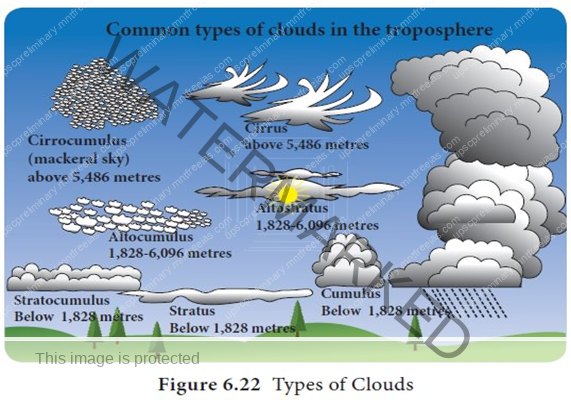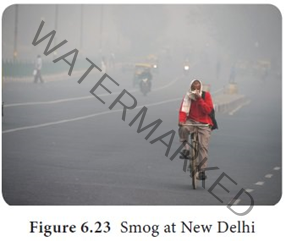- CLOUDS & ITS TYPES
UNIT 4 – CLIMATOLOGY – PART 27
CLOUDS
Cloud is a mass of minute water droplets or tiny crystals of ice formed by the condensation of the Water Vapour in free air at considerable elevations.
As the clouds are formed at some height over the surface of the earth, they take various shapes. According to their height, expanse, density and transparency or opaqueness clouds are grouped under four types:
(I) CIRRUS; (II) CUMULUS; (III) STRATUS; (IV) NIMBUS
CLOUDS AND ITS TYPES
- HIGH CLOUDS: Mainly cirrus (Ci)which are feathery form at 6 km above the ground.
- CIRRUS (CI) – This looks fibrous and appears as wisps cotton in the blue sky. It indicates fair weather and gives brilliant sun set.
- CIRRO CUMULUS (Cc) – This appears as white globular masses, forming a mackerel sky.
iii. CIRROSTRATUS (Cs) – This resembles a thin white sheet. The sky looks milky and the sun and moon shines through these clouds and form a ‘halo’.
- MIDDLE CLOUDS: Mainly Alto (Alt)clouds at 2 km to 6 km above the ground.
- Altocumulus (Alt-Cu): These are woolly, bumpy clouds arranged in layers appearing like waves in the blue sky. They indicate fine weather.
- Altostratus (Alt-St): These are denser and have watery look.
- LOW CLOUDS:
Mainly Stratus or sheet clouds below 2 km height.
Stratocumulus (St-Cu): This is rough and bumpy clouds with wavy structure.
- Stratus (St): This is very low cloud, uniformly grey and thick, appears like highland fog. It brings dull weather and light drizzle. It reduces the visibility and is a hindrance to air transportation.
- viii. Nimbostratus (Ni-St): This is dark dull cloud, clearly layered, as it brings rain, snow and sleet and it is called as rainy cloud.
- Clouds with vertical extent: Theseare mainly cumulus clouds whose heights extend from 2 km to 10 km approximately.
- Cumulus (Cu): This is vertical cloud with rounded top and horizontal base, associated with convectional process in the tropical region. It also called as ‘fair weather cloud’.
- Cumulonimbus (Cu-Ni): This is overgrown cumulus cloud with great vertical extent, with black and white globular mass. The cauliflower top spreads like an anvil. This is formed due to heavy convection in the tropical regions. It is accompanied by lightning, thunder, and heavy rainfall.
Precipitation
Precipitation The process of continuous condensation in free air helps the condensed particles to grow in size.
When the resistance of the air fails to hold them against the force of gravity, they fall on to the earth’s surface.
So, after the condensation of water vapour, the release of moisture is known as precipitation. This may take place in liquid or solid form.
The precipitation in the form of water is called rainfall, when the temperature is lower than the 00 C, precipitation takes place in the form of fine flakes of snow and is called snowfall.
Sleet is frozen raindrops and refrozen melted snow-water. When a layer of air with the temperature above freezing point overlies a subfreezing layer near the ground, precipitation takes place in the form of sleet.



